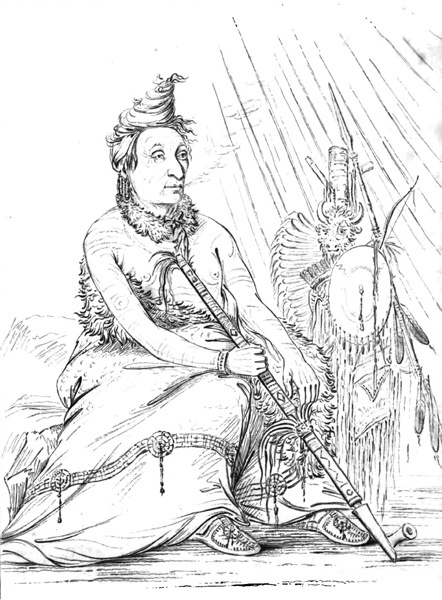Lewis, interpreters René Jusseaume and Toussaint Charbonneau, and five men embark on a diplomatic mission to a Hidatsa village. Two Hidatsa chiefs—Black Moccasin and Red Shield—come to Fort Mandan with similar intentions.
Two Hidatsa Chiefs
by Yellowstone Public Radio[1]Originally aired weekdays by Yellowstone Public Radio during the Bicentennial observance of 2003-2006. Narrated by Hal Hansen. Scripts by Whit Hansen and Ed Jacobson. Produced by Leni Holliman. © … Continue reading
Eehk-tohk-pah-she-pee-shaw (the Black Moccasin)
George Catlin (1796–1872)
Rare Book Division, The New York Public Library. “Minatarree. 79. Eehk-tohk-pah-she-pee-shaw (the Black Mocasin), Head Chief of the tribe, said to be 105 years old when his portrait was painted . . . .”[2]New York Public Library Digital Collections. Accessed November 2, 2019. https://digitalcollections.nypl.org/items/510d47da-da55-a3d9-e040-e00a18064a99.
Lewis Visits the Hidatsa
Capt. Lewis the 2 Intrepreters & Six men Set off this morning in order to go 24 miles abo. this place to a nation of Indians called the [blank] Capt. Lewis & the Intr. Rode on horseback 5 men went in a pearogue [pirogue] up the the Missourie
—John Ordway
Black Moccasin and Red Shield
two Chiefs Came to See me to day one named Wau-ke-res-sa-ra, a Big belley and the first of that nation who has visited us Since we have been here, I gave him a Handkerchef Paint & a Saw band, and the other Some fiew articles, and paid a perticular attention which pleased them verry much, the interpeters being all with Capt. Lewis I could not talk to them.
—William Clark
Of his subject (see figure), the artist George Catlin wrote:
This man has many distinct recollections of Lewis and Clarke, who were the first explorers of this country, and who crossed the Rocky Mountains thirty years ago. It will be seen by reference to their very interesting history of their tour, that they were treated with great kindness by this man; and that they in consequence constituted him chief of the tribe, with the consent of his people; and he has remained their chief ever since. He enquired very earnestly for “Red Hair” and “Long Knife” (as he had ever since termed Lewis and Clarke), from the fact, that one had red hair (an unexampled thing in his country), and the other wore a broad sword, which gained for him the appellation of “Long Knife.”
Later in St. Louis, Catlin showed about a hundred of his recent portraits to William Clark who “instantly recognized” Black Moccasin among them. Clark state “‘they had considered the Black Moccasin quite an old man when they appointed him chief thirty-two years ago.'”[3]George Catlin, Letters and Notes on the Manners, Customs, and Condition of the North American Indians (London: Tosswill and Myer, 1841) 1:186–87.
Weather Diary
Ther. at rise
Weather Wind at rise
Thert. at 4 P.M. Weather Wind at 4 P.M. 34 fair W 32 fair S W set out with Charbono and Jessome to visit the Indian hunting camps. spent the evening with the black mockersons the Prince. Cheif of the little Vilage grosventres [Hidatsas].
—Meriwether Lewis[4]To assist the reader, the editor of this web page has omitted the date column, merged the “River” columns, and spelled out some abbreviations.
Fort Mandan is a High Potential Historic Site along the Lewis and Clark National Historic Trail managed by the U.S. National Park Service. The North Dakota Department of Parks and Recreation manages a modern reconstruction and the Lewis and Clark Interpretive Center located at US Hwy 83 and ND Hwy 200A.
Knife River Indian Villages National Historic Site is a High Potential Historic Site along the Lewis and Clark National Historic Trail managed by the U.S. National Park Service. A unit of the National Park System, the site is located at 564 County Road 37, one-half mile north of Stanton, North Dakota. It has exhibits, trails, and a visitor center.
Notes
| ↑1 | Originally aired weekdays by Yellowstone Public Radio during the Bicentennial observance of 2003-2006. Narrated by Hal Hansen. Scripts by Whit Hansen and Ed Jacobson. Produced by Leni Holliman. © 2003 by Yellowstone Public Radio. |
|---|---|
| ↑2 | New York Public Library Digital Collections. Accessed November 2, 2019. https://digitalcollections.nypl.org/items/510d47da-da55-a3d9-e040-e00a18064a99. |
| ↑3 | George Catlin, Letters and Notes on the Manners, Customs, and Condition of the North American Indians (London: Tosswill and Myer, 1841) 1:186–87. |
| ↑4 | To assist the reader, the editor of this web page has omitted the date column, merged the “River” columns, and spelled out some abbreviations. |
Experience the Lewis and Clark Trail
The Lewis and Clark Trail Experience—our sister site at lewisandclark.travel—connects the world to people and places on the Lewis and Clark Trail.
Discover More
- The Lewis and Clark Expedition: Day by Day by Gary E. Moulton (University of Nebraska Press, 2018). The story in prose, 14 May 1804–23 September 1806.
- The Lewis and Clark Journals: An American Epic of Discovery (abridged) by Gary E. Moulton (University of Nebraska Press, 2003). Selected journal excerpts, 14 May 1804–23 September 1806.
- The Lewis and Clark Journals. by Gary E. Moulton (University of Nebraska Press, 1983–2001). The complete story in 13 volumes.




